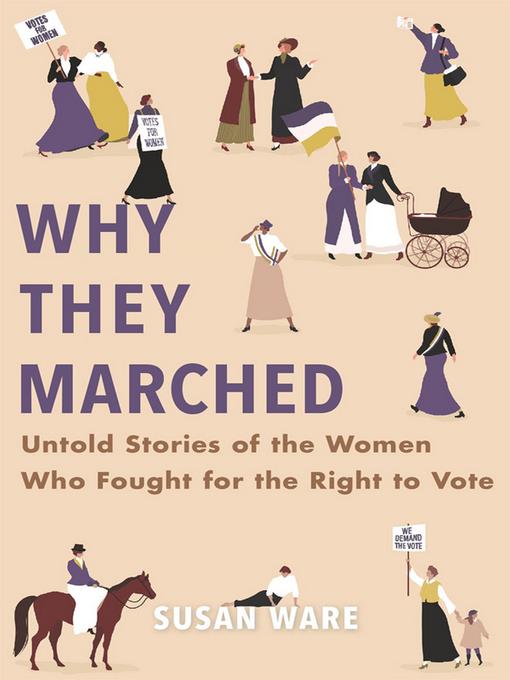
Why They Marched
Untold Stories of the Women Who Fought for the Right to Vote
- اطلاعات
- نقد و بررسی
- دیدگاه کاربران
نقد و بررسی

Starred review from April 1, 2019
Historian and biographer Ware (American Women’s History: A Very Short Introduction) crafts a smart, eclectic collection of 19 mini-biographies of Americans who worked for women’s suffrage. Ware’s take is fresh; she includes subjects in less-discussed locales (such as Massachusetts “farmer suffragettes” Molly Dewson and Polly Porter, or Utah Mormon suffragette Emmeline Wells), and analyzes cultural artifacts such as newspaper cartoons by women cartoonists and buttons worn by activists to highlight the various ways movement ideas were communicated. The first of the book’s three sections, “Claiming Citizenship,” opens with Susan B. Anthony voting in the 1872 election in Rochester, N.Y., justifying doing so with her interpretation of the Fourteenth Amendment: as citizens, women had the right to vote. In the second part, “The Personal is Political,” Ware’s subjects illustrate how the suffrage movement changed women’s private lives; Illinois activist Ida Wells-Barnett, for instance, backed a losing Chicago mayoral candidate in 1915, which cost her her job as a probation officer. The final section, “Winning Strategies,” focuses on a new generation of suffrage supporters’ dramatic tactics, as when, in 1909, Dr. Cora Smith Eaton climbed Washington’s Mount Rainier to stake a “Votes for Women” banner. Though heavily reliant on stories of white women, Ware’s excellent compendium expertly shows there are new ways to tell the suffrage story. This is a must-read for those interested in women’s and American history. Illus.

Starred review from April 1, 2019
One hundred years ago, in 1919, the Nineteenth Amendment was finally submitted to the states for ratification. The road to the Nineteenth Amendment and women's suffrage was long and arduous, and many key players have been forgotten or lost among names such as Elizabeth Cady Stanton and Susan B. Anthony. Historian and biographer Ware (American Women's History: A Very Short Introduction) does a wonderful job of highlighting people and subjects often passed over when exploring the fight for women's rights, including names such as Mary Church Terrell, Rose Schneiderman, Claiborne Catlin, and Emmeline W. Wells. Ware does not shy away from some of the controversies often hidden when studying suffragism, namely racism, and is able to give both a broad and detailed look at the movement through her thoughtful choices of chapter subjects. This text brings to light fascinating stories underrepresented in traditional looks at women's suffrage in the United States, providing just the right amount of detail in each chapter before moving on to yet another enthralling tale. VERDICT Those interested in 18th- and 19th-century American history, specifically women's history, would enjoy this comprehensive read.--Rebecca Kluberdanz, Central New York Lib. Resources Council, Syracuse
Copyright 2019 Library Journal, LLC Used with permission.

March 15, 2019
A collection of inspiring stories of the women who fought for the 19th Amendment.Refreshingly, Ware (American Women's History: A Very Short Introduction, 2015, etc.), the honorary women's suffrage centennial historian at the Schlesinger Library, focuses on many of the lesser-known but equally audacious, talented women who joined the fight, profiling 19 courageous individuals who thought for themselves and brought their husbands willingly with them. "To bring the story of the...movement to life," writes the author, "I have organized the narrative as a prosopography featuring nineteen discrete but overlapping biographical stories." Many suffragists were abolitionists first, which both strengthened and weakened their cause, as the same arguments against granting votes for black men were applied to women. The feminist movement merged with the suffragists in the early 1900s, and feminism brought a broader commitment to economic independence, sexual emancipation, and freedom from the need to marry. Individual states began to give women the vote slowly, beginning with Utah in 1870, although it was temporarily repealed in 1887 in an attempt to control polygamous marriage. By 1896, Colorado, Wyoming, and Idaho had given women the vote. Those who fought for enfranchisement were often writers, artists, and cartoonists, and their work was put to good use in designs for banners, buttons, and posters and in publications like Alice Stone Blackwell's Woman's Journal and Charlotte Perkins Gilman's Forerunner. There were also those who were practically a one-woman show--e.g., Claiborne Catlin, who raised awareness in Massachusetts during her long unfunded pilgrimage on horseback. Ware also discusses the experiences of black women, like Ida B. Wells and Sojourner Truth, who faced not only sexism, but racism as well. Mary Church Terrell, the daughter of wealthy ex-slaves, not only traveled to Europe, but also addressed the Berlin International Council of Women in 1904. By 1919, most of the Western states had granted women the vote; the next fight would take all their talents to gain ratification of the amendment.Important American history that is also timely given recent attempts at voter suppression.
COPYRIGHT(2019) Kirkus Reviews, ALL RIGHTS RESERVED.




دیدگاه کاربران